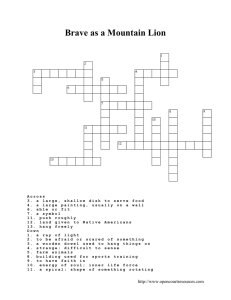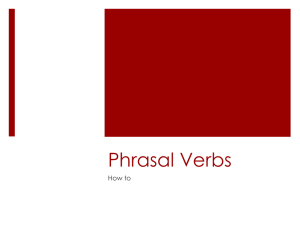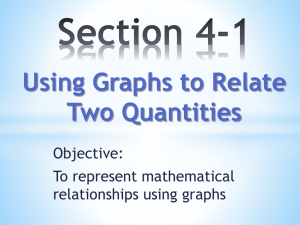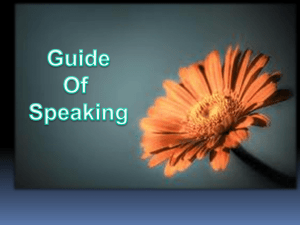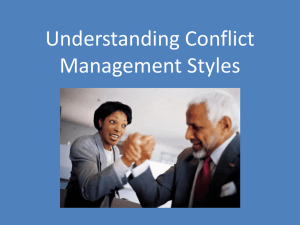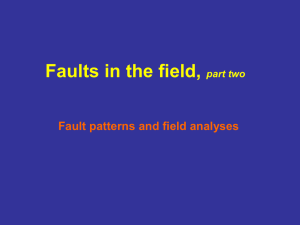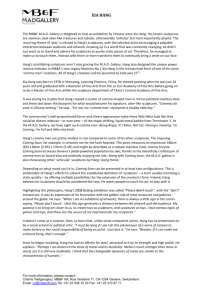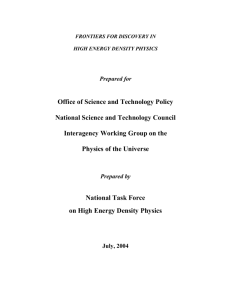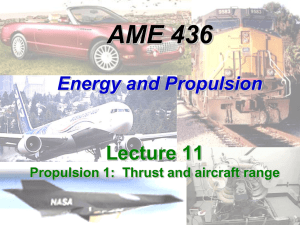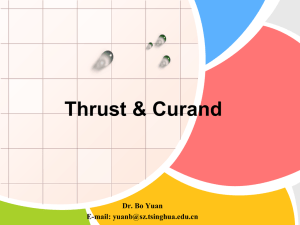Patterns of Coordination
advertisement
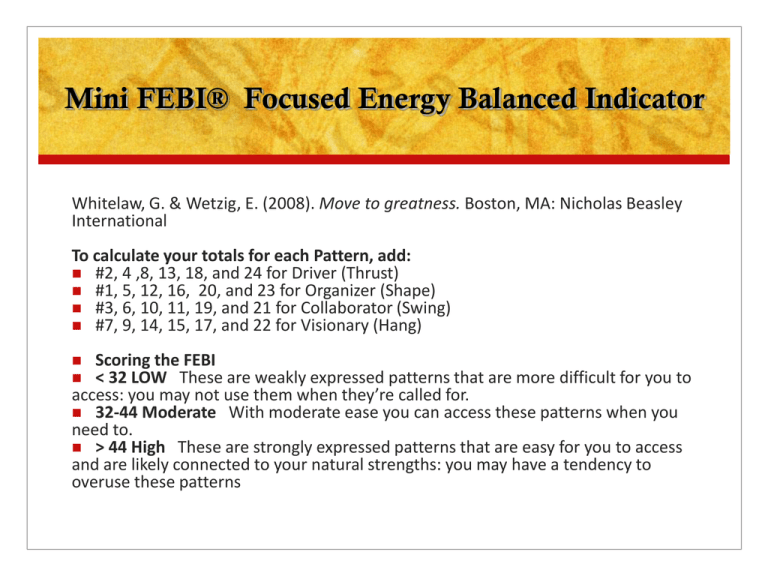
Mini FEBI® Focused Energy Balanced Indicator Whitelaw, G. & Wetzig, E. (2008). Move to greatness. Boston, MA: Nicholas Beasley International To calculate your totals for each Pattern, add: #2, 4 ,8, 13, 18, and 24 for Driver (Thrust) #1, 5, 12, 16, 20, and 23 for Organizer (Shape) #3, 6, 10, 11, 19, and 21 for Collaborator (Swing) #7, 9, 14, 15, 17, and 22 for Visionary (Hang) Scoring the FEBI < 32 LOW These are weakly expressed patterns that are more difficult for you to access: you may not use them when they’re called for. 32-44 Moderate With moderate ease you can access these patterns when you need to. > 44 High These are strongly expressed patterns that are easy for you to access and are likely connected to your natural strengths: you may have a tendency to overuse these patterns LEARNING STYLES: Patterns of Coordination “A difference unaddressed becomes a disability.” James Collins Learning Styles & Diversity Diversity is the goal of helping all students develop to their unique and fullest potential by varying instruction, assessment, and content to both support students in the use of their own resources and challenge them to acquire and understand the resources of others. Why do we value Diversity? Different students need different styles of instruction to acquire the learning we offer. Different students need different modes of assessment to demonstrate their learning. Each child’s interests and talents, concerns, and fascinations are the best foundation for increasing that child’s ability and motivation to learn. The operation of democracy requires an in-depth understanding of a variety of perspectives and contributions, as well as the ability to listen and learn from the lives and cultures of a variety of people. PPinciotti Do you love me still? Or Do you love me Moving? The more intelligent a person is, the more originality is found in others. Ordinary people see no differences between men. Blaise Pascal PPinciotti Moving With Our Hands Draw a Symbol for How you move How do you Know? Think of an Activity What do you do First? What do you do Last? Describe or Draw how you Organize something. PPinciotti Development, learning, and intelligence are… “connected to movement and dependent upon it.” Maria Montessori Movement, Learning and the Brain SPARK: The revolutionary new science of exercise and the brain “Only a mobile person needs a brain. That which we call thinking is the evolutionary internationalization of movement.” Rodolfo Llinas Three essential factors in healthy brains John J. Ratey, M.D. Education – Learning new things, new skills Self- efficacy – Belief in your ability to impact your own thinking and actions Movement – Exercise, activity, aerobic work “Automatic patterns of thinking and movement are stored in the basal ganglia, cerebellum, and brain stem… Movement helps the brain learn, sparks the master molecule of the learning process in the hippocampus.” J. Ratey PPinciotti Background: Ways of Moving Four Patterns of Movements first discovered by kinesiologist Dr. Josephine Rathbone -1930’s Validated by electrophysiological recordings by Dr. Valerie Hunt et al. in the 1960’s Elisabeth Wetzig labeled these Coordination Patterns® and connected them to overall temperament and learning style Pat Pinciotti applied Wetzig’s work to education, learning and teaching Ginny Whitelaw linked Patterns to overall effectiveness in life, work and the balance between them - Move to Greatness [www.movetogreatness] FEBI (Focus Energy Balance Indicator) – Assesses mind-body patterns preferences PPinciotti Learning Styles • • • Learning Style examines the way we perceive, approach a task, organize, and use specific strategies to be successful as learners. Learning involves the coordination of body and mind, heart and hand, self and culture. Movement provides a window into how a child perceives, learns, works, and makes sense of the world. Observation of movement and language while planning and working indicates learning style, intelligences, and sensory strength. PPinciotti Learning Styles Lens • Discover important insights into individual ways of thinking, learning, and working • Assess your own personal learning style and how it connects and interacts with others • Accept and enjoy the uniqueness of individuals and the dynamic nature of relationships • Make the job of parenting, teaching, collaborating and leading easier, more predicable and more harmonious • Anticipate potential trouble spots, negotiate typical minefields, and lay the groundwork for future growth and development PPinciotti Let’s MOVE! PPinciotti Principles of the PATTERNS OF COORDINATION Your brain and body are connected through the central nervous system and you brain seeks patterns to make meaning Movement provides a window into understanding an individual’s mental processing There are four primary ways of moving and thinking called Coordination Patterns: Thrust, Shape, Swing, and Hang Each Coordination Pattern is a connection between moving and thinking which includes a quality and type of movement and quality and type of mental processing We each have a Home Pattern and a Pattern Hierarchy Style is a combination of two Patterns – our Home Pattern plus another Pattern Goal is to recognize and use all four Patterns as tools to create Balance PPinciotti PATTERNS OF COORDINATION IT is all about MOVEMENT! THRUST - diagonal, zig-zag, asymmetry, sharp turns, aware of strength, directionality SHAPE - right angles, symmetry, placed turns, sequential, arithmetic, classical weight, SWING - back and forth, big-little balance, meander, aware of trunk/body HANG - follow, flow, random, hang turns, aware of energy, connections PPinciotti Where do our • Nature: Difference evident at birth • Habit: Difference reinforced with use • pattern preferences Developmental: Stages call out different patterns • come from? • • Judith Krestenberg’s research maps the patterns and role of movement in the early stages of child development. • • “The Terrible Twos” – DriverThrust pattern The Sociable Threes – Collaborator-Swing pattern The Rule Bound Fours – Organizer-Shape pattern The Inquisitive, Rambunctious Fives – Visionary-Hang pattern Nurture: Family and culture can positively or negatively effect patterns PPinciotti EACH PATTERN INVOLVES A QUALITY AND TYPE OF MOVEMENT AND A QUALITY AND TYPE OF THINKING. PPinciotti Thrust Driver PPinciotti You see - Assertiveness, testing, directness, Look for - Strength, presence, pushing tools, images, asymmetrical movements/ designs Modality - Visual Thinking - Planning for Action, sometimes too quick, impatient, or volatile; Needs to take time Needs - Security, visual engagement, success, loves to win, independence Interactions - Logical, brief, organized, friendly not gushy, support independence, Demonstrate, Show them how, Encourage sense of honor naming, reorganizing, visual recognition, Skills PPinciotti Shape Organizer PPinciotti You see - Attention, thinking, questions, sorting, placedness, prioritizing, correct form, knowledge Look for - Stillness, sequence, symmetry, time, reliability Modality - Auditory Thinking – Analytic, May be narrow, rigid, or timid, Encourage boldness and adventure Needs - Undivided attention, rules, recognition, to do the right thing Interactions - Answer question, explain, Pay attention to time, Sequence learning, one thing at a time, be correct, Encourage duty PPinciotti Swing Collaborator PPinciotti You see - Interaction, embellishment, competency, feelings, playfulness, comparisons, multi-tasking, Imagination Look for - Rocking back and forth, interaction, moving in and out of lesson, sees both sides Modality - mixed, use two for checking Thinking flaw - Surface; waffles on decisions; needs to think more clearly and deeply Needs - Social interaction and multi-tasking, fun! Interactions - Playful, loyal, chatty, daydreamer, doodles, applaud often, Encourage responsibility PPinciotti Hang Visionary PPinciotti You see - Moving, hanging out, seeking essence, improvising, connections, kinetic experiential learning, whole picture/absorb, Intuition Look for - Need to move in random ways, flexibility and looseness, Modality - Kinesthetic, whole body Thinking flaw – Scattered, leaps; Lacks follow-thru; needs a System for organizing Needs - Challenge, physical experiences, organization; big picture Interaction - Physical presence, enjoy energy, help them organize, find words, be flexible/open, praise connections, fairness, Encourage service PPinciotti Individual Style in Action PPinciotti PATTERNS OF COORDINATION Strengths & Limitations “A difference unaddressed becomes a disability.” James Collins PATTERNS OF COORDINATION: Benefits Discover important insights into individual ways of thinking, learning, and working. Assess your own personal learning style and how it connects and interacts with others. Anticipate potential trouble spots, negotiate minefields, lay the groundwork for future growth and development. Accept and enjoy the uniqueness of individuals and the dynamic nature of relationships. Make interactions easier, more predicable and life more harmonious and balanced. ppinciotti The Normalized Classroom FULL P0TENTIAL LEARNING: Putting Patterns into Action Ef f ective teaching that leads to understanding MOVES the learner through content and skills in all four ways. THRUST – Intentional Mentor SWING – Supportive Coach ÒPlay w ith meÓĞ opens perceptions explores possibilities Develops competency, encourages f eelings and successful relations Process orientation, explores possibilities w ti hout criticism Uses interaction with materials and others, dialogue, valuing, imagery, metaphor Embellis h by playing around, try it another way, enrich Needs emotional acceptance and support, group interaction, ebb & flow Assessment Ğ Ò my voice in dialogue with othersÓ SHAPE – Knowledgeable Instructor ÒTell meÓ, impart knowledge, information, correct f acts and form Develops know e l dge base, curiosity what to think about; what shape to put it in Questions and engages in reading, research or dialogue to get inf ormation Uses thinking; cause and ef f ect, order, rules Follow s sequence or steps in planning and execution Needs recognition; one to one relating; direct instruction Assessment Ğ Ò the voice of the expertÓ ÒShow meÓhow to do it; direct; hands-on; demonstrations Develops skills through activity, doing, making, drills Production orientation, pattern and predictability, standards of excellence Uses naming; restructuring; pinpoint f unctions; big picture; juxtaposition Secure in ability to perform; sense of master or control Needs to work alone at the task; security; diagonal relations Assessment Ğ Ò in my own voic eÓ HANG – Individual Challenger ÒLet me be w ti h itÓ, seeks essence; absorbs; explores potential Strengthens dispositions towards learning, risk-taking and creating Makes connections; free associations, randomness Uses energy and movement to know and connect Experiential, takes risks, why not? Makes concepts, ideas, medium physical; gets messy Needs risks; movement and problem-finding opportunities; random relations Assessment Ğ Ò the voice of experienceÓ PPinciotti PPinciotti What can you do to promote harmony among the unique individuals in your world? PPinciotti So….Go Move! Your first and foremost job as a leader is to take charge of your own energy and then to help orchestrate the energy of those around you. Peter Drucker PPinciotti
